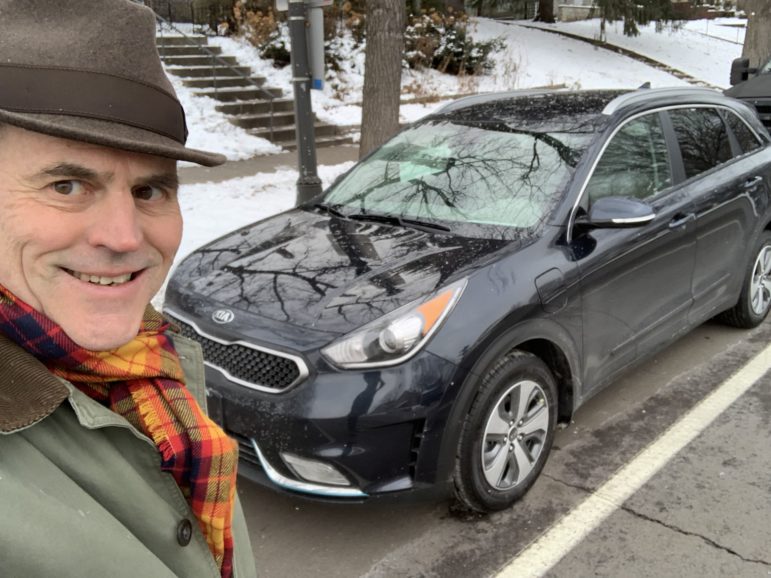 We’ve said it before—electric vehicles and renewable energy are like peanut butter and jelly: they’re great on their own, but they’re so much better together. Electric vehicles are a smart choice for the electric grid, they’re better for our air, and they help families save money. So it’s no surprise that collectively Fresh Energy staff, board, and our families own a total of nine plug-in vehicles.
We’ve said it before—electric vehicles and renewable energy are like peanut butter and jelly: they’re great on their own, but they’re so much better together. Electric vehicles are a smart choice for the electric grid, they’re better for our air, and they help families save money. So it’s no surprise that collectively Fresh Energy staff, board, and our families own a total of nine plug-in vehicles.
But our executive director Michael Noble has been one of the last hold-outs.
Michael and his wife Patsy have been a one-car household since 1988. Their fifteen-year-old Pontiac Vibe has both gotten them around town and taken the couple across the United States—from road trips to beautiful national parks in Arizona to camping in Minnesota’s own Boundary Waters. But 170,000 miles later, Patsy and Michael were ready for a new car.
This summer, Michael scoped out several dealerships to explore electric vehicle options. He was set on a plug-in hybrid electric vehicle (PHEV), preferably with all the latest safety features and heated seats. The first sales rep with whom he spoke was adamant Michael’s preferred choice—a Kia Niro PHEV—was a bad one. The car was $4,000 more than the regular hybrid Niro, the salesman insisted, ignoring the obvious point that the plug in was eligible for a $4,500 federal tax credit. The second dealer understood the logistics and mechanics of driving electric, but the salesperson Michael worked with simply didn’t have many on his lot and couldn’t get a decent supply from Kia. Of the millions of cars sold last year in the country, just over 2 percent were electric vehicles. And the vast majority of these cars sell in the ten Zero Emission Vehicle (ZEV) states, with California leading the way.
Minnesota has a clean car access problem. While car lots in places from rural Vermont to downtown Los Angeles will boast zero-emissions vehicle options, Minnesota dealerships are conspicuously lacking. Michael’s preferred dealer only received five or so plug-in electric hybrids a year—and the sales manager couldn’t predict timing on new arrivals. Because Minnesota has not adopted electric-vehicle supporting policies like tax-incentives or California’s ZEV Standard, car manufacturers simply aren’t shipping very many clean, electric cars to our state.
But Michael was determined. After months of waiting on a potential Minnesota shipment of his desired Kia Niro PHEV with no firm timeline in place from the dealer, he finally turned to the internet. Michael connected with a dealer in southern Illinois who was both willing to sell him the Kia and drive it out to Minnesota—free-of-charge. Michael’s car arrived early December, driven across the country to his home in Saint Paul by two septuagenarian veterans. The car plugs right into a normal outlet in the garage and is rated by the Environmental Protection Agency to get 105 miles-per-gallon equivalent. “It’s the perfect car for us,” Michael says, “but the hoops we went through for it were completely unnecessary. It’s incredible there are so many wonderful electric vehicles in other states, all potentially powered from the wind and sun, and we just can’t get many models here.”
It’s time for Minnesota to become the country’s eleventh Zero Emissions Vehicle state. If we’re to truly make an impact in reducing carbon emissions and reach ambitious greenhouse gas reduction benchmarks, we need cleaner transportation options. Fresh Energy is optimistic our state’s new elected leaders will take a stand and push for our Minnesota adoption of the zero-emission, clean car standards. Let’s lead from the North.
Stay tuned for more updates by signing up for our newsletter and make sure to follow Michael on Twitter to congratulate him on the new wheels.
